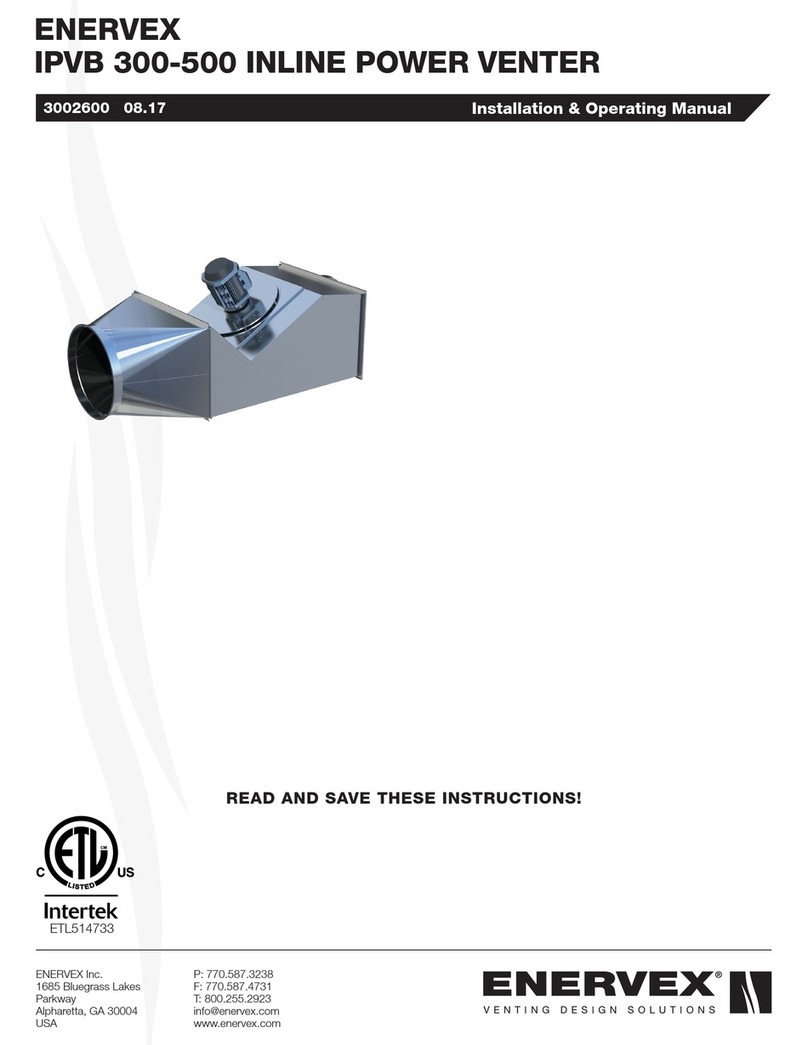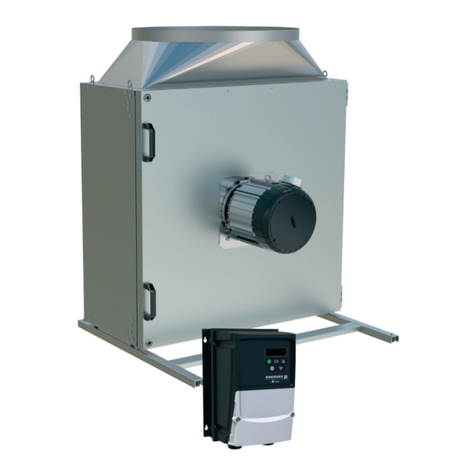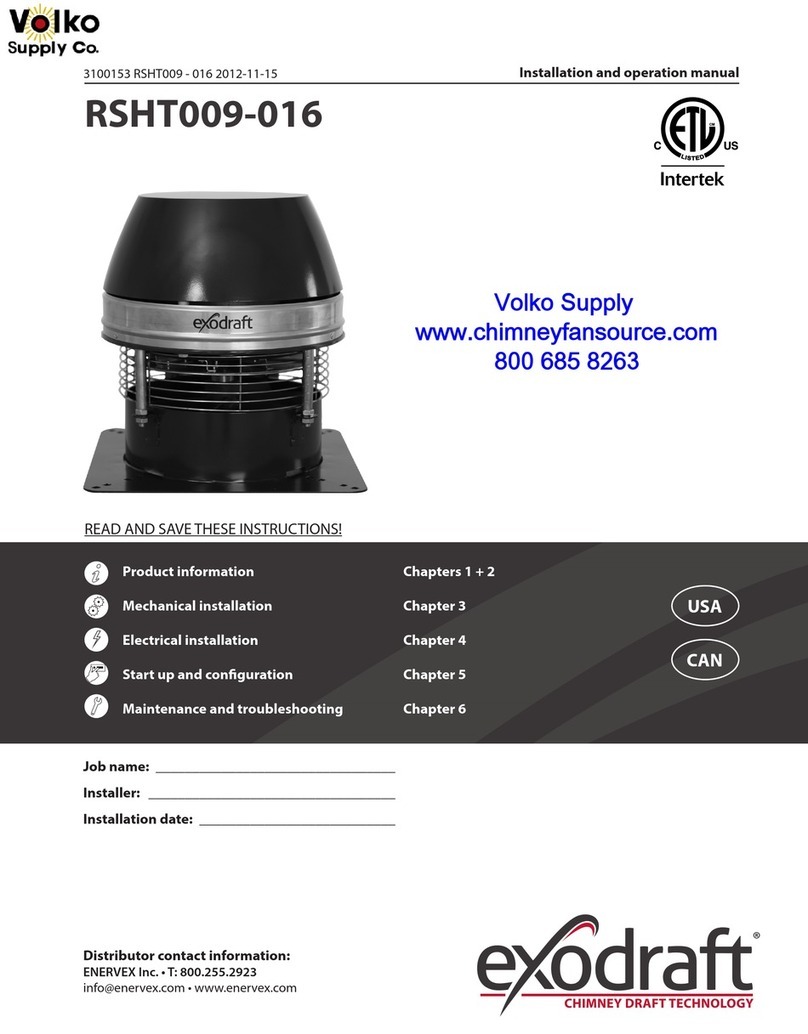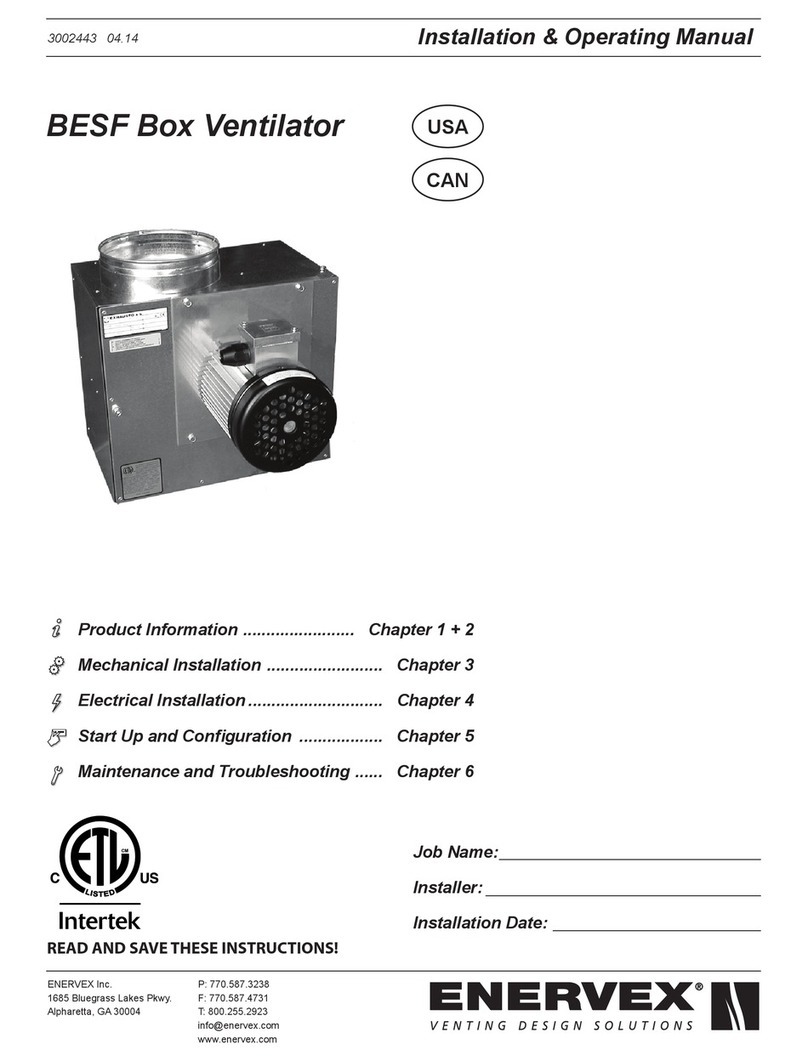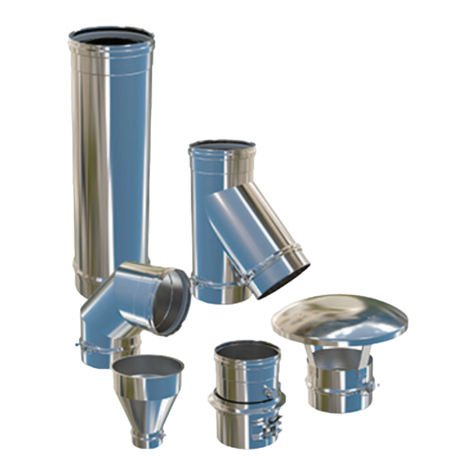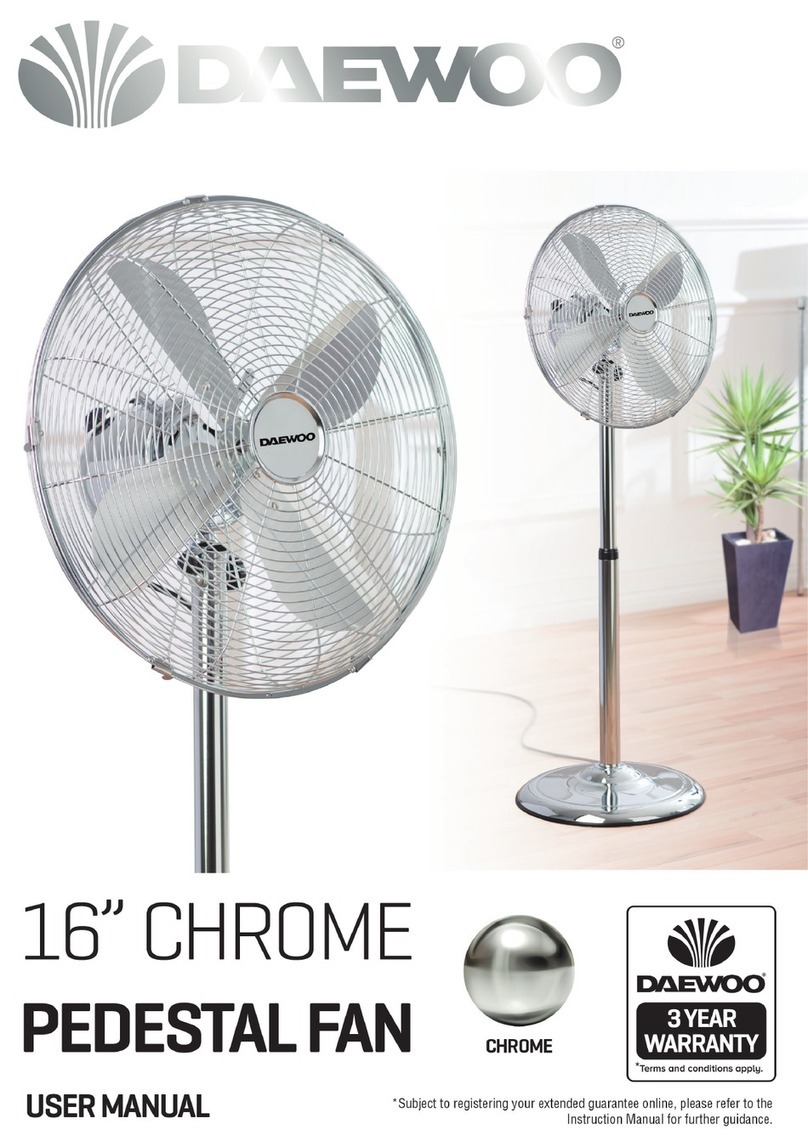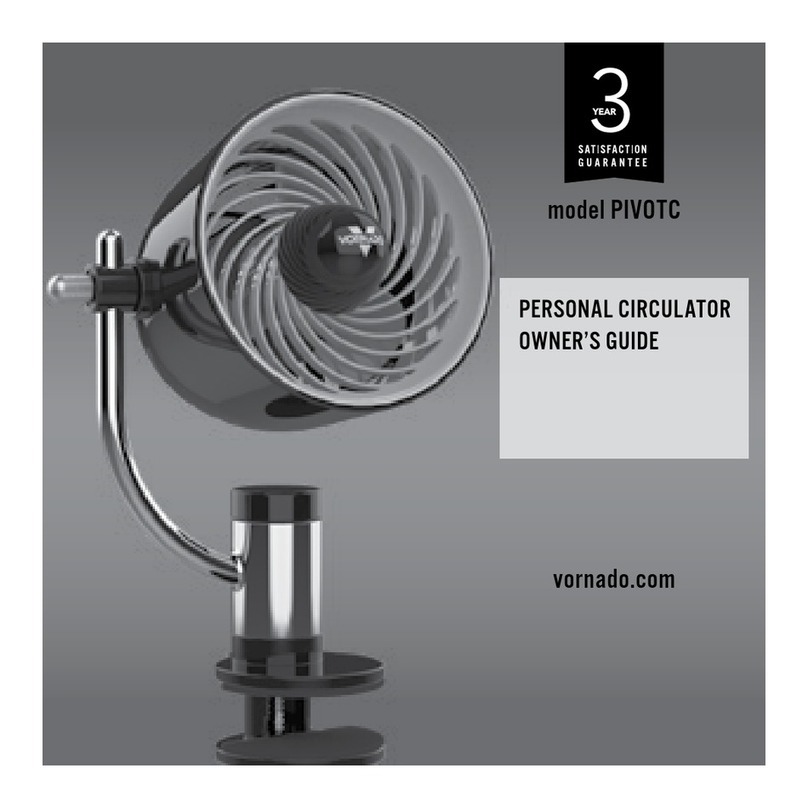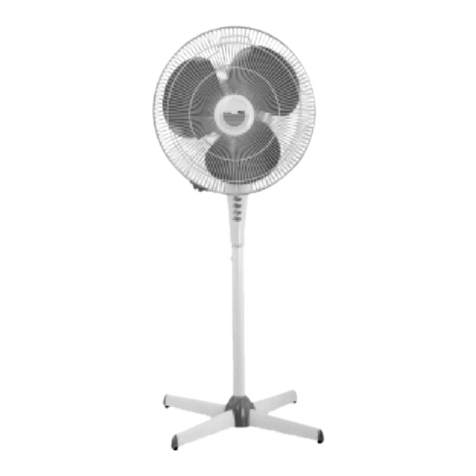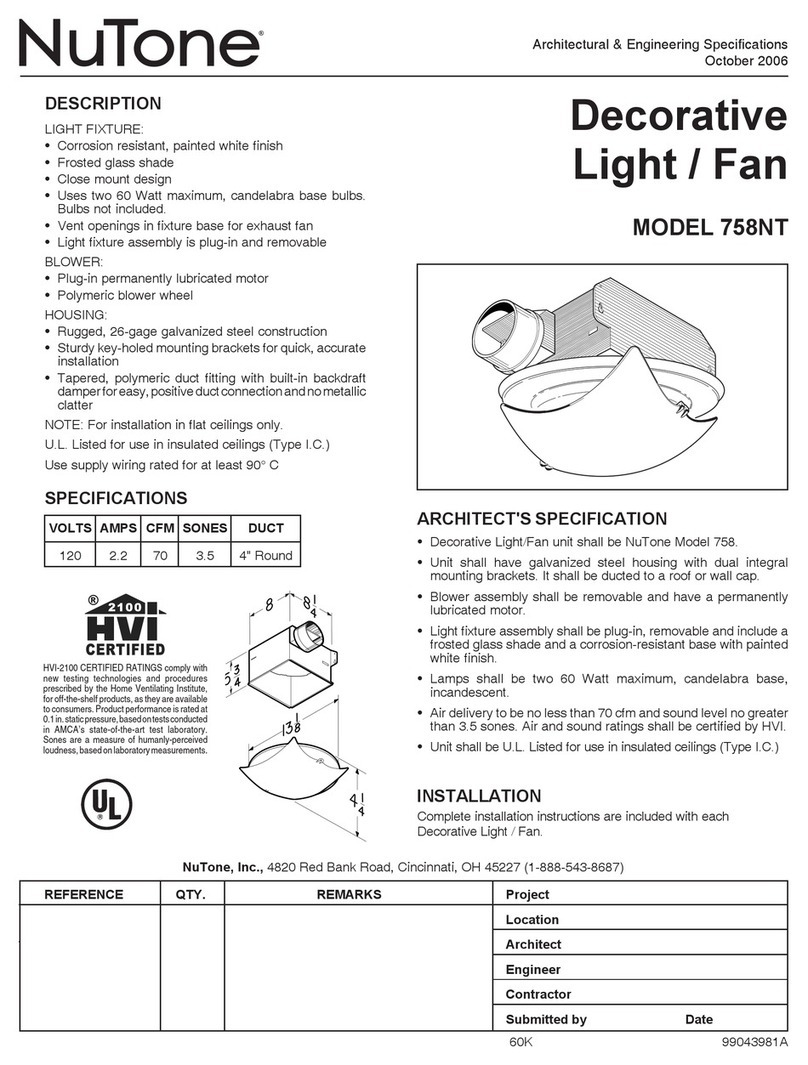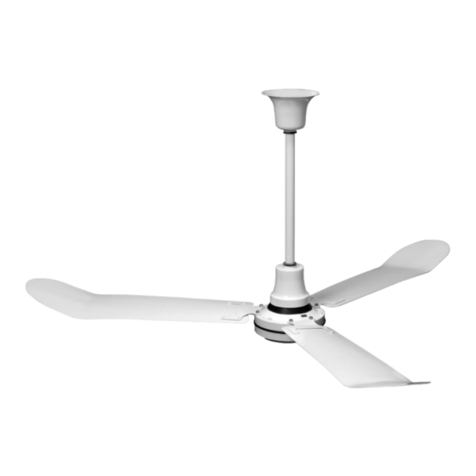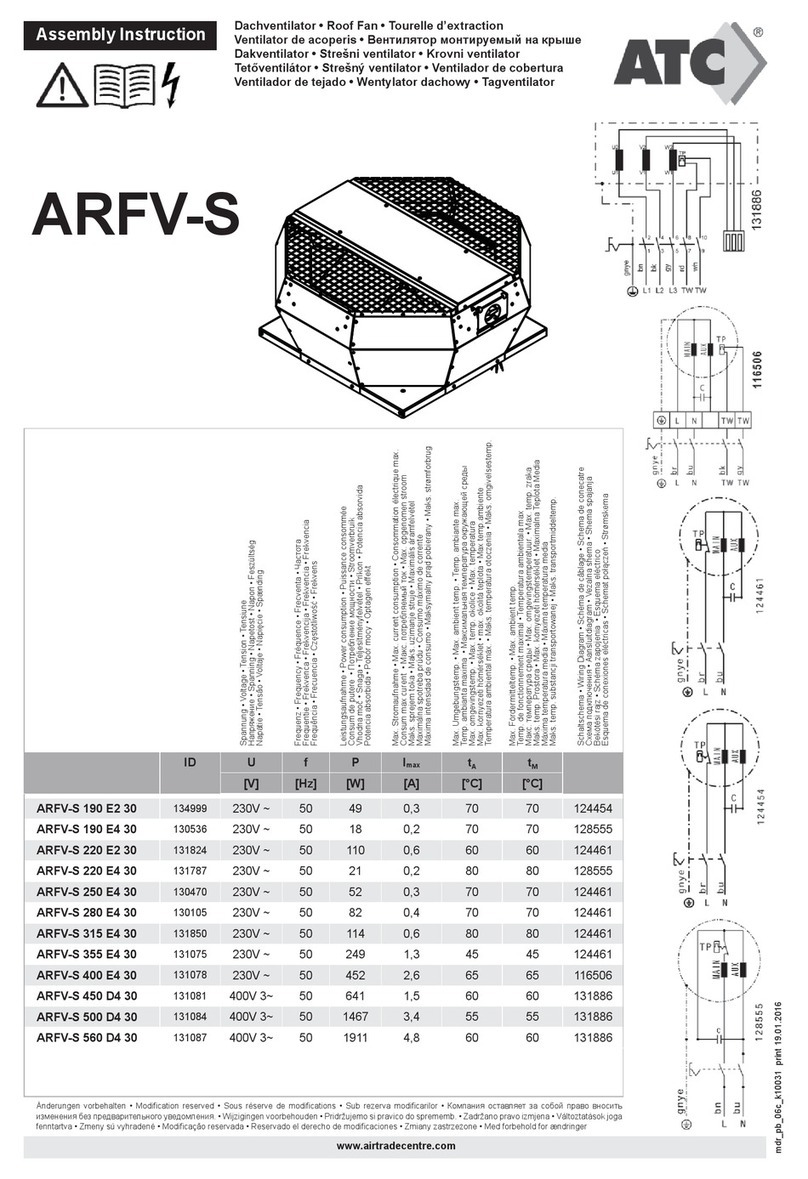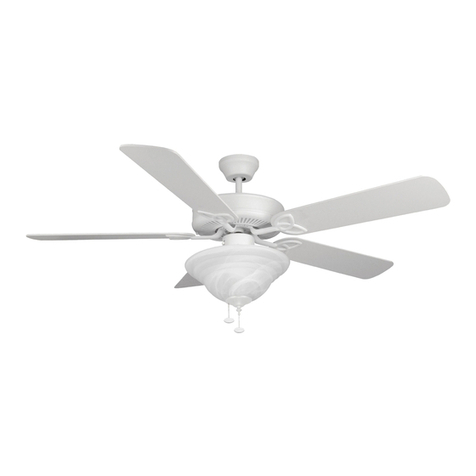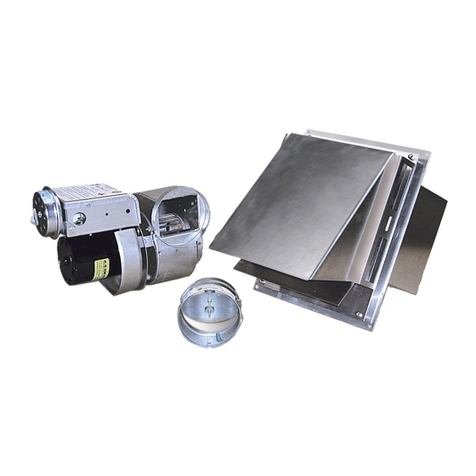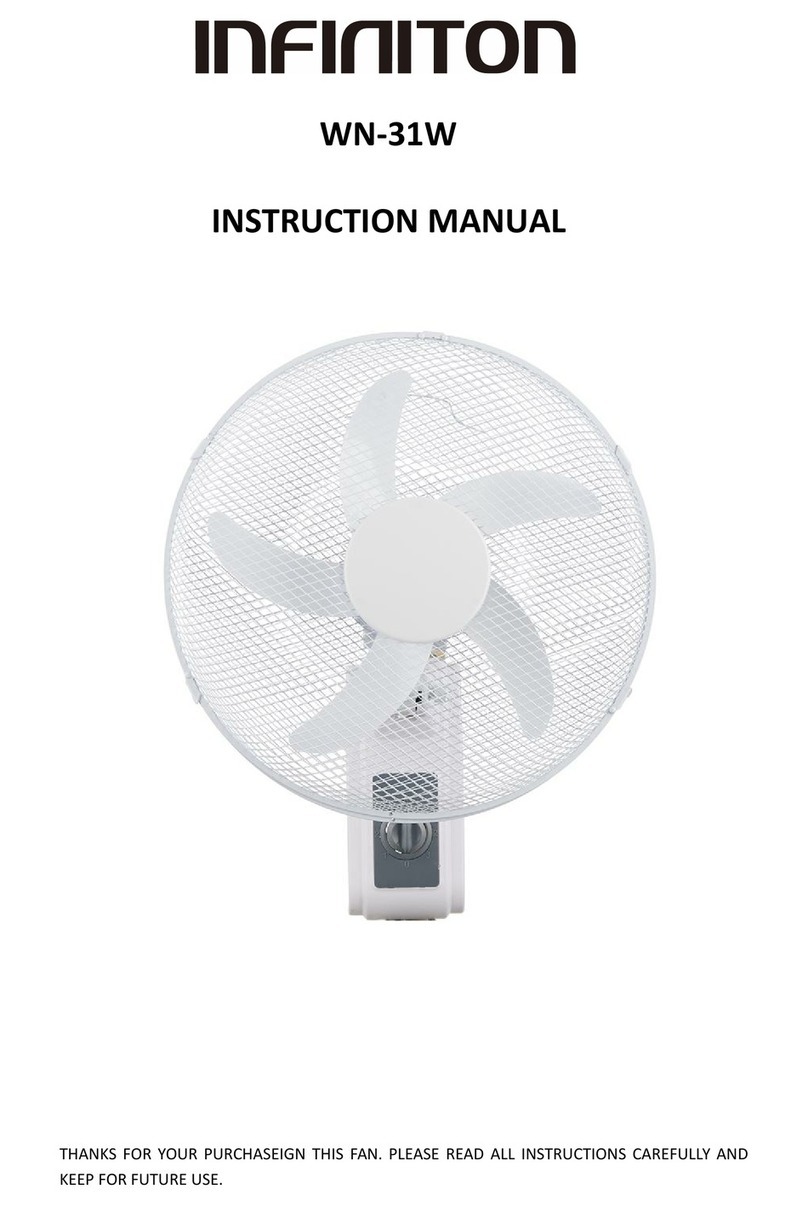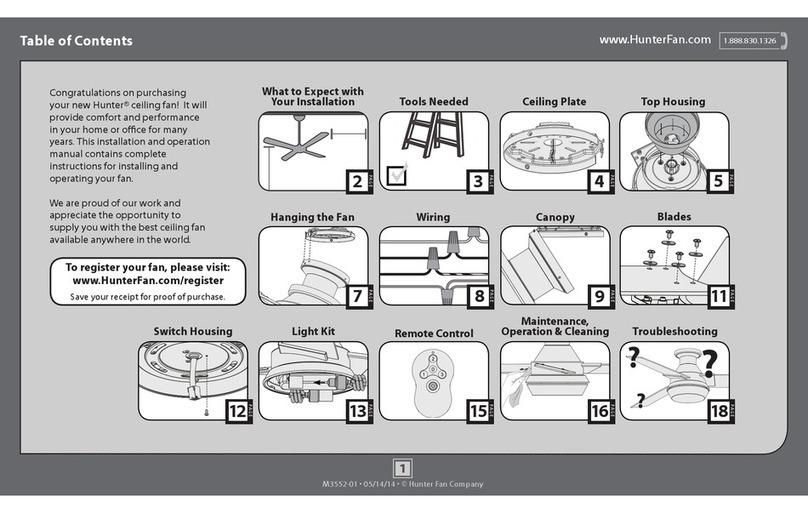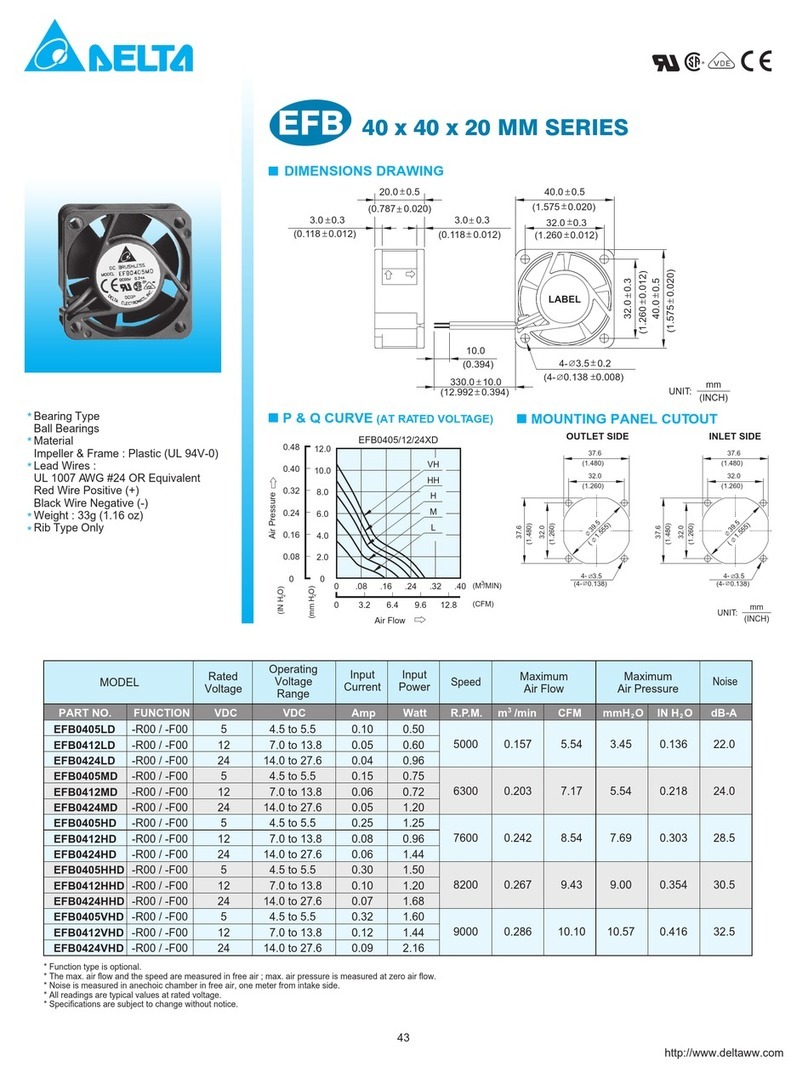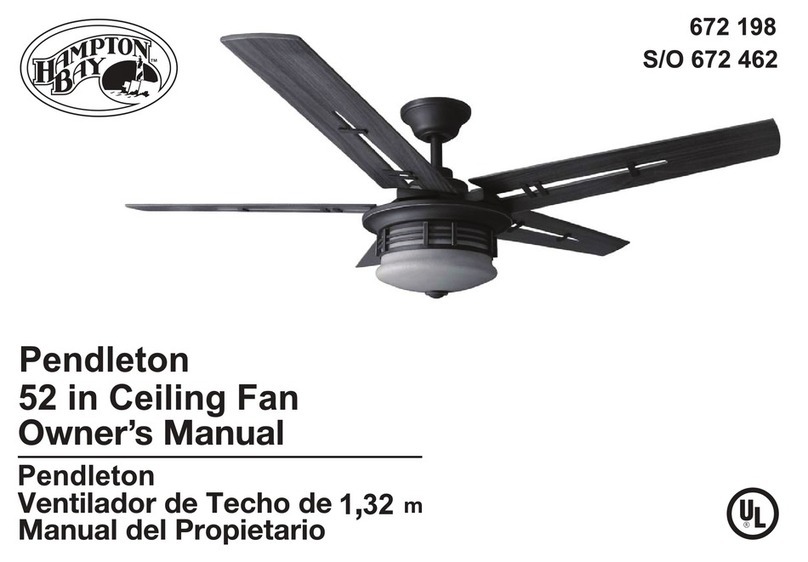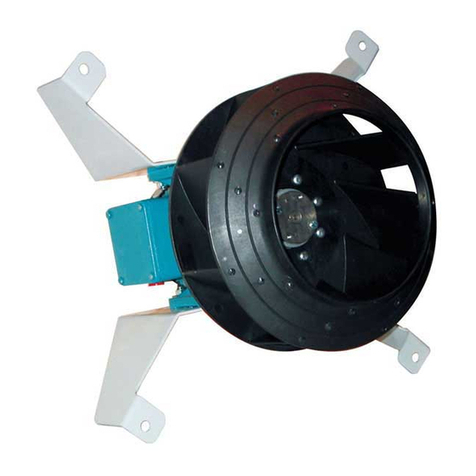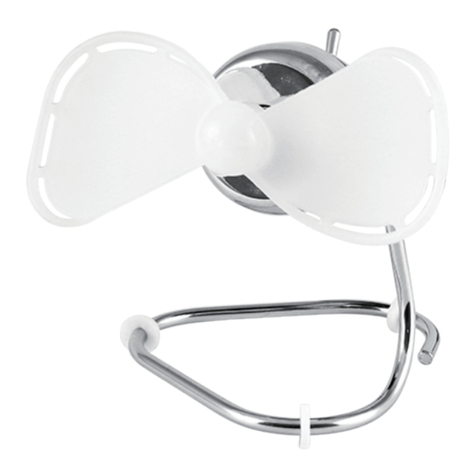ENERVEX RS 009 Installation instructions

ENERVEX Inc.
1685 Bluegrass Lakes
Parkway
Alpharetta, GA 30004
USA
P: 770.587.3238
F: 770.587.4731
T: 800.255.2923
www.enervex.com
3000270 05.16 Installation & Operating Manual
ENERVEX
RS CHIMNEY FAN FOR GAS & OIL APPLICATIONS
READ AND SAVE THESE INSTRUCTIONS!
ETL514733

2
3000270 05.16
Symbol Legend
The following terms are used throughout this manual to bring
attention to the presence of potential hazards, or to important
information concerning the product.
DANGER: Indicates an imminent hazardous
situation which, if not avoided, will result in death,
serious injury or substantial property damage.
WARNING: Indicates an imminent hazardous
situation which, if not avoided, may result in
personal injury or property damage.
DANGER: Indicates an imminent electrical shock
hazard which, if not avoided, will result in death,
serious injury or substantial property damage.
How to use this manual
This installation manual does not contain any system design
documentation. System design documentation is available
from any authorized ENERVEX representative. Accessories,
fans, and variable frequency drives are not covered by
this manual. Please refer to these component’s individual
manuals.
TO REDUCE THE RISK OF FIRE,
ELECTRICAL SHOCK OR INJURY TO
PERSONS, OBSERVE THE FOLLOWING:
1. Use this unit in the manner intended by the manufacturer.
If you have questions, contact the manufacturer at the
address or telephone number listed on the front of the
manual.
2. Before servicing or cleaning the unit, switch off at service
panel and lock service panel to prevent power from being
switched on accidentally.
3. Installation work and electrical wiring must be done by a
qualified person(s) in accordance with applicable codes
and standards.
4. Follow the appliance manufacturer’s guidelines and safety
standards such as those published by the National Fire
Protection Association (NFPA), and the American Society
for Heating, Refrigeration and Air Conditioning Engineers
(ASHRAE), and the local code authorities.
5. This unit must be grounded.
This symbol shows that ENERVEX RS Chimney Fans for solid fuel applications are listed under ETL File no. 514733.
ETL514733

3
3000270 05.16
1. GENERAL INFORMATION
1.1 Function ............................................................................................4
1.2 Shipping............................................................................................4
1.3 Warranty............................................................................................4
2. SPECIFICATIONS AND DIMENSIONS
2.1 Dimensions and Capacities ...............................................................5
2.2 Planning Ahead .................................................................................6
3. MECHANICAL INSTALLATION
3.1 Transport Safety Device.....................................................................7
3.2 Single Fan on Steel Chimney .............................................................7
3.3 Single Fan on Brick Chimney.............................................................8
3.4 Multiple Fans on Steel Chimney.........................................................9
3.5 Multiple Fans on Brick Chimney - Oversized Flue...............................9
3.6 Installation for High Temperatures......................................................9
3.7 Wall Mounting of Chimney Fan ..........................................................10
3.8 Installation of Proven Draft Switch (PDS)............................................10
3.9 Termination of Venting System...........................................................10
4. ELECTRICAL INSTALLATION
4.1 General .............................................................................................12
4.2 Wiring Diagram for Single Fan with FSC ............................................12
4.3 Wiring for Two Fans with FSC............................................................13
4.4 Wiring Diagram for Single Fan with ADC 100.....................................13
5. STARTUP AND CONFIGURATION
5.1 System Testing ..................................................................................14
5.2 Adjusting the Chimney Fan Speed.....................................................14
5.3 Adjusting the Proven Draft Switch Setting..........................................14
6. MAINTENANCE AND TROUBLESHOOTING
6.1 Prior to Cleaning................................................................................15
6.2 Care and Cleaning.............................................................................15
6.3 Chimney Cleaning Intervals................................................................15
6.3 Troubleshooting..................................................................................16
Content

4
3000270 05.16
1. GENERAL INFORMATION
1.1 FUNCTION
The RS Chimney Fan is a chimney top mounted ventilator
that is designed to provide large flue gas volume capacities.
It is designed and intended for use with residential gas or oil
fired central space heating systems, for volume water heating
or for combination space heating/volume water heating. It is
also suitable for use with gas-fired fireplaces, stoves, BBQ’s
or residential pizza ovens.
This product is developed to prevent draft problems from
occurring by creating a mechanical draft in venting systems
and thereby also increasing the capacity and efficiency of a
venting system.
The use of the RS Chimney Fan is not restricted to any type
of chimney, because the fan creates a negative pressure
(below atmospheric) in the chimney or vent.
Code Compliance
Installations must conform to requirements of the authority
having jurisdiction. Where required by the authority having
jurisdiction, the installation must also conform to the
Standard for Draft Equipment and The National Fuel Gas
Code, ANSI Z223.1/NFPA 54.
All electrical wiring must be in accordance with the
requirements of authority having jurisdiction or, in the
absence of such requirements, with the National Electrical
Code, NFPA70.
Listings
The Model RS is tested and listed to UL Standard 378,
Standard for Draft Equipment. The fan is manufactured
at an ISO9001 certified plant and bears the European CE
compliance label.
The chimney fan must be interlocked with the connected
appliance(s) to insure proper combustions and to avoid flue
gas spillage.
1.2 SHIPPING
The packing list (attached to one of the packages) clearly
lists all items in the shipment and each package has a label
showing the contents. Check the list against all materials on
the job site for completeness.
NOTE: All single phase fans are shipped with a capacitor and
junction box connected via conduit. The capacitor is located
INSIDE the junction box. Please do not discard.
1.3 WARRANTY
ENERVEX products are warranted for a period of two (2)
years following the date of invoice. Replacement or repair
will be at ENERVEX’s discretion, provided factory inspection
shows a defect in material or workmanship.
Complete warranty conditions are available from ENERVEX.

5
3000270 05.16
2. SPECIFICATIONS
2.1 DIMENSIONS & CAPACITIES
Capacity
43
2
1
12
11
10
9
8
7
6
5
0250 500 750 1000 1250 1500 1750 2000
1.0
0.9
0.8
0.7
0.6
0.5
0.4
0.3
0.2
0.1
0.0
Volume (cfm)
Ps (inW.C.)
RS 016
RS 014
RS 012
RS 009
C
A
D
E
B
8 Locking nut
9 Inlet
10 Axial vane
11 Hinges
12 Capacitor
(inside junction box)
1 Junction box
2 Conduit/cord
3 Motor
4 Motor housing
5 Motor plate
6 Bird screen
7 Base plate
Sound Data
Model
Lw dB (measured in accordance with ISO 3744) Lp
dB(A)
125Hz 250Hz 500Hz 1000Hz 2000Hz 4000Hz 8000Hz
RS009 54 50 47 43 38 31 25 21
RS012 64 60 55 52 48 42 34 30
RS014 75 69 65 62 57 51 44 41
RS016 81 76 72 69 64 58 52 47
Model RS 009 RS 012 RS 014 RS 016
Discharge Horizontal
Fan Type Axial Vane
Motor Type Totally enclosed, Variable speed, Class H
Voltage VAC 1x120V @ 60 Hz
Amperage Amps 0.5 1.2 1.4 3.9
RPM 1600
CFM @0.0 Ps 450 950 1400 1950
Motor Output hp / kW 1/30 / .025 1/10 / 0.08 1/7 / 0.1 1/3 / 0.25
Weight lbs / kg 29 / 13 37 / 17 47 / 21 61 / 28
kg 13 17 21 28
Dimensions
A in / mm 10.2 / 259 11.5 / 292 13.1 / 334 16.0 / 407
B x B in / mm 11.7 / 296 14.3 / 364 16.6 / 422 18.8 / 478
C in / mm 10.8 / 275 13.5 / 344 15.5 / 395 17.4 / 441
D in / mm 3.0 / 75 3.3 / 85 3.9 / 100 3.9 / 100
E in 9.4 / 238 11.6 / 294 13.5 / 342 15.4 / 391
Temperature
Rating
Interm. 575°F / 300°C
Cont. 482°F / 250°C

6
3000270 05.16
2.2 PLANNING AHEAD
Observe proper combustion air requirements.
Provide a firm support system for the chimney fan.
Determine the type of system involved.
Observe proper safety measures are taken
to assure safe use of the wood burning
appliances.
!
Adequate fresh air must be provided for
combustions; otherwise improper operation
and inadequate venting of deadly flue gases
may result.
!
Combustion Air Requirements
Provisions for combustion air must be in accordance with
applicable local codes.
If the heating system is installed in an unconfied space,
adequate air vill be available via normal infiltration.
If the heating system in installed in a confined space, (a space
with a volume less than 50 cubic feet per 1,000 Btu/hr of
input for all fuel burning equipment) or building construction
is unusually tight, adequate air for combustion must be
provided by two openings: one located about 6" below the
ceiling, the other about 6" above the floor. Each opening
must have a minimum free area as follows:
1. One square inch per 4,000 Btu/hr of input when
communicating directly with the outside or through
a vertical duct.
2. One square inch per 2,000 Btu/hr when communication
through horizontal ducts to the outisde.
3. One square inch per 1,000 Btu/hr when ventilation air
is provided by openings in doors, etc. to adjoining spaces
having adequate infiltration.
Support system for the chimney fan
Prior to installation of the chimney fan, it must be assured the
chimney can safely carry the weight of the chimney fan.
A steel chimney should be well supported at the roof
penetration point. If the chimney extends more than 20'
above the roof, the chimney and the fan should be secured
by wires attached on the chimney and on the roof at 2 to 3
different points.
Brick chimneys usually do not need any kind of support to
carry the weight of the chimney fan.
System type
Direct connect oil or gas appliances (no draft hood) normally
do not require any mechanical draft adjustment. However,
if there are long horizontal breechings and far between
the appliances, it is a good idea to install mechanical vent
dampers, so adjustments of the draft can be easily made.
Draft hood systems could generally speaking have vent
dampers installed. The vent dampers are used to balance
the system and assure that only a minimum of dilution air is
pulled through the draft hoods.
Safety Devices
Local codes usually require installation of safety devices,
when mechanical draft is provided in an oil or gas fueled
system.
Make sure a differential pressure switch (proven draft switch)
is installed to assure that no appliance will fire unless there is
a proven draft.

7
3000270 05.16
3. MECHANICAL INSTALLATION
3.1 TRANSPORT SAFETY DEVICE
If a transport safety device is present, remove it from the
vane and make sure that the vane can revolve without
hindrance.
RS 14/16: Before mounting, the transport safety device on
the hinges must be removed.
3.2 SINGLE FAN ON STEEL CHIMNEY
Step 1: Prepare fan location
If a stack cap is already installed, it must be removed. The
steel chimney adapter (SCA) slides right into the chimney,
where the long collar engagement ensures safe anchoring.
If necessary, the adapter can be secured by means of long
self-tapping stainless steel screws into the side of the collar
through the chimney wall.
Measure the inside diameter of the flue and cut a
corresponding hole in the center of the fiber mat. If the flue
is so big that the throat in the adapter has been reduced
to fit the throat of the fan, the hole in the fiber mat should
correspond to the throat.
The aluminum foil on the fiber mat must face upward (against
fan base).
Step 2: Preparation of fan
Locate the installation brackets in the grooves on the
underside of the fan base, using the bolts and nuts supplied
to secure the brackets. Note that the bolts shall be installed
from the bottom side in the two inner holes.
Adjust the final position of the installation brackets ensuring
that there is a small gap between the brackets and the flue
wall/adapter throat. Tighten the nuts. If the brackets touch
the flue wall, it may create some vibration noise.
Step 3: Attaching the fan
The chimney fan is now ready for installation on the top of the
chimney. Place the fiber mat with the aluminum foil facing
upwards on the top of the adapter, and place the fan on top
of the mat. High temperature silicone can be applied on the
side of the mat, but is not required. It can also be painted. It
is not necessary to bolt the fan to the chimney.
If the steel chimney is air-cooled, a special
adapter for such chimney must be used.
!
CAUTION
Under conditions with extremely strong winds
surrounding the top of the chimney, the
chimney fan must be secured by steel wires
supplied with the fan.
!

8
3000270 05.16
CAUTION
Under conditions with extremely strong winds
surrounding the top of the chimney, the
chimney fan must be secured by steel wires
supplied with the fan.
!
3.3 SINGLE FAN ON BRICK CHIMNEY
Step 1: Prepare fan location
The installation procedure is the same whether the flue is
round or square. If a clay tile flue liner is installed, it might
stick up a few inches. Cut it back so it is flush with or no
more than 1/2 inch above the chimney crown.
Measure the inside diameter of the flue, cut a corresponding
hole in the fiber mat leaving a minimum distance of 3/4" to
any side of the fiber mat.
The aluminum foil on the fiber mat must face upwards
(against fan base).
Step 2: Preparation of fan
Locate the installation brackets in the slots going through
the fan base, using the bolts and nuts supplied to secure the
brackets. If the flue diameter is larger than the chimney fan
inlet, the bracket can be installed underneath the base. Note
that the bolts must be installed from the bottom side.
Adjust the final position of the brackets ensuring that there
is clearance between the brackets and the flue wall. If the
brackets touch the wall, it may generate some vibration
noise.
Step 3: Attaching the fan
The chimney fan is now ready for installation on the top of
the chimney. Place fiber mat with the aluminum foil facing
upwards on the top of the chimney, and place the fan on top
of the mat.
High temperature silicone can be applied on the side of the
mat, but is not required. It can also be painted.
It is not necessary to bolt the fan to the chimney.

9
3000270 05.16
3.4 MULTIPLE FANS ON STEEL CHIMNEY
If two or more chimney fans are required to create sufficient
draft, installation procedures are the same as for single fan
installation on a steel chimney. The only difference is that the
fans are sitting next to each other on the top of the chimney.
A special adapter plate is required.
When installing multiple fans, it is extremely important that
the fans are of the same model and size, and they must be
controlled in tandem by one (1) motor speed control.
3.5 MULTIPLE FANS ON A BRICK CHIMNEY -
OVERSIZED FLUE
If two or more fans are required to create sufficient draft, a
special adapter plate is required. The adapter plate should be
made of stainless steel (14 GA or thicker), depending on the
size and the fan models used.
The two holes in the plenum box should match the throat
diameter of the fan model used and the distance from center
to center should be at least equal to the fan width (dimension
“B” in 1.5. Dimensional data).
The adapter should be sealed with silicone and bolted
onto the top. When installing multiple fans, it is extremely
important that the fans are of the same model and size, and
they must be controlled in tandem by one (1) motor speed
control.
A similar approach should be taken if the flue size exceeds
the fan base dimensions. The adapter plate should be sized
so it covers the flue and secured. A hole should be cut in the
center of the plate and the fan mounted centered over the
hole.
3.6 INSTALLATION FOR HIGH TEMPERATURES
If the fan is used for applications where the flue gas
temperatures exceed 400°F at the flue exit, and does not
exceed 650°F, dilution bolts must be used.
Dilution bolts will cause cool air to dilute the warm flue gas,
by lifting the fan and leaving space so the cool air can get in
under the fan base.
The dilution bolts should be installed in the outer holes in the
fan base.
The dilution bolts are adjustable and should be adjusted
so the flue gas temperature does not exceed 400°F when
discharged through the fan. When using dilution bolts the
fan’s actual capacity is reduced and a stronger model may
be required. The fiber mat is not required when using dilution
bolts.

10
3000270 05.16
3.7 WALL MOUNTING OF CHIMNEY FAN
When mounting the chimney fan on a wall, the installation
instructions for installation on a steel chimney should be
followed. Use of the adapter SCA can make the installation
easier, but is not a requirement.
To ease installation, detach the fan base by removing the
bolts holding the hinges together. Center the fan base over
the outlet and bolt the base onto the wall with the hinges
pointing upwards.
After mounting the base securely, attach the fan motor
housing by reassembling the fan hinges. Seal with silicone all
around the fiber mat to prevent rain from entering the flue.
Bolt
Bolt
CAUTION
A safety device that prevents the heating
appliance operation, in case of a power failure
or inadequate draft situation, must be installed.
!
3.9 TERMINATION OF VENTING SYSTEM
In order to achieve optimal performance and energy
consumption for the RS Fan or GSV Fan, the duct must be
installed as shown below and the distances observed. From
the last elbow to the termination point the distance has to be
3 times the diameter of the flue. For example if you using 12in
flue (12 X 3 = 36in). So the distance from the last elbow to
the fan termination point should be 36 inches..
A venting system that terminates in the sidewall of a structure
shall terminate at least 3 ft (0.9 m) above any air inlet to the
structure that is within 10 ft (3 m) of the termination point.
Exception No. 1: This requirement shall not apply to the
combustion air intake of a direct vent appliance.
Exception No. 2: This requirement shall not apply to the
separation distance between the circulating air inlet and the
vent discharge of a listed outdoor appliance.
The flue gas outlet of an appliance other than a direct vent
appliance shall terminate at least 4 ft (1.2 m) below, 4 ft (1.2
m) horizontally from, or 1 ft (0.3 m) above any door, window,
or gravity air inlet of the structure. The outlet also shall
terminate at least 1 ft (0.3 m) above grade.
3.8 INSTALLATION OF PROVEN DRAFT SWITCH (PDS)
A safety system must be interlocked with the appliance(s).
The safety system could utilize a Proven Draft Switch,
a thermal switch or a flow switch. The device must be
interlocked with the heating appliance so it shuts down in
case of insufficient draft, fan failure or power failure. Please
refer to the PDS Installation Manual if this control is used.
For more information on alternative safety systems, please
contact ENERVEX, Inc.
The figure shows the location of the probe for the PDS.
Location is important to make sure there is enough pressure
or draft available or the switch to work.

11
3000270 05.16
The combustion air inlet and flue gas outlet of a direct vent
appliance or the flue gas outlet of an appliance other than a
direct vent appliance shall terminate at least 1 ft (0.3 m) from
the soffit of the roof of the structure and at least 3 ft (0.9 m)
from an inside corner of an L-shaped structure.
The flue gas outlet terminal of a direct vent application with an
input of 50,000 Btu/hr (0.35 gal/hr) or less shall be located at
least 9 in. (230 mm) from any door, window, or air inlet to the
structure. The vent terminal of a direct vent appliance with an
input over 50,000 Btu/hr (0.35 gal/hr) shall be located at least
1 ft (0.3 m) from any door, window, or air inlet to the structure.
Regardless of input, the flue gas outletterminal shall also
terminate at least 1 ft (0.3 m) above grade.
The exit terminals of mechanical draft systems shall not be less
than 7 ft (2.1 m) above grade when located adjacent to public
walkways.
Any air inlet and any flue gas outlet of any appliance shall
terminate at least 5 ft (1.6 m) from the vent outlet of a supply
tank.
Source: NFPA 31: Standard for the Installation of Oil-Burning Equipment

12
3000270 05.16
4. ELECTRICAL INSTALLATION
4.1 GENERAL
All electrical wiring must be in compliance with the local
codes or in their absence, with the National Electric Code,
NFPA 70 — latest edition. If an external electrical source is
utilized, system must be electrically grounded in accordance
with requirements of the authority having jurisdiction or, in the
absence of such requirements, with the National Electrical
Code NFPA 70 — latest edition.
Power requirements for the system depends on the fan size.
Electrical requirements are:
• RSHT009 1 x 120 V/60 Hz 0.4 Amps
• RSHT012 1 x 120 V/60 Hz 1.2 Amps
• RSHT014 1 x 120 V/60 Hz 1.4 Amps
• RSHT016 1 x 120 V/60 Hz 3.9 Amps
The chimney fans have a split capacitor motor with infinitely
variable speed.
The fan speed control supplied is rated 1 x 120 V/60 Hz and
5 Amps. It has an adjustable low voltage set point of min. 65
V +/- 5 V.
DANGER
Turn off electrical power before servicing.
Contact with live components can cause shock
or death.
NOTICE
If any of the original wire supplied with the
system must be replaced, use similar wire
of the same terperature rating. Otherwise,
insulation may melt or degrade, exposing bare
wire.
!
24V GAS VALVE
COM
TR
HOT
TH
PROVEN DRAFT
SWITCH
RED
WHITE
BLACK
GREEN
FAN
MOTOR
120/1/60
24 VAC
NOTES:
THE DISCONNECT MEANS AND CIRCUIT PROTECTION ARE TO
BE PROVIDED BY THE INSTALLER OF THIS DEVICE
1
All wiring must be in
flexible or rigid metal
conduit
LEGEND:
24 VAC
120 VAC
WEATHERPROOF BOX
N
L
FAN SPEED
CONTROL
ORANGE
4.2 WIRING DIAGRAM FOR SINGLE FAN WITH FAN
SPEED CONTROL
The wiring diagram at right shows the wiring of the chimney
fan and how it is connected to the fan speed control.

13
3000270 05.16
4.3 WIRING DIAGRAM FOR TWO FANS WITH FAN
SPEED CONTROL
The diagrams at right show the wiring of two chimney fans
and how they are connected to the fan speed control.
4.4 WIRING DIAGRAM FOR SINGLE FAN WITH
ADC100
The diagrams at right show the wiring of a single chimney fan
when used in conjunction with an ADC 100P or ADC 100-E
Control.
RED
WHITE
BLACK
GREEN
FAN
MOTOR
120/1/60
NOTES:
THE DISCONNECT MEANS AND CIRCUIT PROTECTION ARE TO
BE PROVIDED BY THE INSTALLER OF THIS DEVICE
1
2
All wiring must be in
flexible or rigid metal
conduit
LEGEND:
24 VAc
120 VAC
WEATHERPROOF BOX
N
FAN SPEED
CONTROL
ORANGE
RED
WHITE
BLACK
GREEN
FAN
MOTOR
WEATHERPROOF BOX
ORANGE
WEATHERPROOF
BOX
L
24V GAS VALVE
COM
TR
HOT
TH
PROVEN DRAFT
SWITCH
24 VAC
24V GAS VALVE
OR IGNITION
COM
TR
HOT
TH
24 VAC
ADC 100

14
3000270 05.16
5. STARTUP AND CONFIGURATION
5.1 SYSTEM TESTING
Before any adjustments are made to the system, follow these
procedures:
1. Turn the chimney fan ON and make sure that it is
operating. Increase and decrease the speed of the fan by
adjusting the fan speed control to make
sure it is operating properly.
2. Turn the fan OFF and make sure the pressure switch
opens, on the power to the circuit it controls is
disconnected.
5.2 ADJUSTING THE CHIMNEY FAN SPEED
Start up all appliances. Use the fan speed control to set the
speed of the chimney fan so no back pressure is experienced
anywhere in the system. Check the system for flue gas
spillage. Mark this setting on the fan speed control cover.
5.3 ADJUSTING THE PROVEN DRAFT SWITCH
SETTING
Remove the snap-on cover from the conduit enclosure by
loosening its retaining screw. Turn the slotted Adjustment
Screw clockwise to raise the set point pressure and counter
clockwise to lower the set point.
Set the adjustment to its lowest position. With all appliances
operating, reduce the speed of the fan to the set point, where
the appliance(s) starts to spill flue gas. Increase the speed of
the fan gradually to the point where there is no more spillage.
Raise the switch’s set point so it opens. Return the fan speed
to the original setting marked on the cover.
The system is now adjusted so the flue gas spillage will
disconnect the heating appliance(s).
The procedure described here may not cover all Proven Draft
Switches, so please review the Installation Manual for the
switch being used.
DANGER
Check other heating appliances (water heater,
furnace, etc.) for proper operation while the
chimney fan is operating. Make sure no flue
gases are spilling out as this can lead to carbon
monoxide poisoning.

15
3000270 05.16
6. MAINTENANCE AND TROUBLESHOOTING
6.1 PRIOR TO CLEANING
Remove butterfly nut or screw from each hinge prior to
cleaning.
Remove Butterfly Nut or
Screw from each Hinge
6.3 CHIMNEY CLEANING INTERVALS
It is extremely important to keep the chimney flue clean from
combustion and deposits. Unburned oil residues can cause
chimney fires.
Cleaning intervals depend on the use of the appliance. The
more the appliance is used, the more often the chimney flue
needs cleaning. As there are no firm guidelines for cleaning
intervals, have the chimney inspected on a regular basis
(every quarter or so) to determine what the interval should be.
Then follow this interval.
No matter how much used, a chimney flue should be cleaned
and inspected at least once every year.
NOTE:
The chimney should be cleaned by a trained professional.
We recommend using a Certified chimney sweep certified by
Chimney Safety Institute of America.
You can find a Certified Chimney Sweep at www.csia.org or
www.ncsg.org or by calling (317) 837-5362 or (317) 837-1500.
6.2 CARE AND CLEANING
The Chimney Fan System is designed for prolonged use.
The fan should be inspected at least one a year when the
chimney is inspected. Fuel residues and other deposits
should be removed from the fan blades and the bottom of
the motor housing.
The top of the fan is hinged and can be opened in order to
ease the cleaning.
NOTICE
If any of the original wire supplied with the
system must be replaced, use similar wire
of the same terperature rating. Otherwise,
insulation may melt or degrade, exposing bare
wire.
!

16
3000270 05.16
6.4 TROUBLESHOOTING
Observation Problem Solution
There is no power going to the fan
– The circuit breaker may be off
– Fan speed control is off
– Bad electrical connections
– Check the circuit breaker
– Turn fan speed control on
– Check and correct problem
There is power to the fan but it is not
operating
– Bad electrical connections
– The fan speed control’s low voltage
setting is too low
– The fan speed control is bad
– Check and correct problems with
connections. Pay special attention to the
wiring in the junction box
– Increase the setting with the plastic
screw on the fan speed control’s front plate
– Replace the fan speed control
There is power to the fan but it hums and
does not turn
– The motor run capacitor may be bad.
– Creosote may stick
– Check capacitor and replace if necessary
– Clean fan
The fan seems to work fine, but there is
not enough draft – The fan may be undersized – Replace with a larger fan
The fan vibrates – The motor shaft may be bent – Replace motor
There is airflow noise from the fireplace
opening
– The flue is undersized.
– The fan is oversized and running too fast
– There is not much to do about it. Try to
reduce the fireplace opening
– Reduce the fan speed
Mechanical noise can be heard – Foreign matter may be stuck
– Motor bearings may be worn out
– Remove matters
– Replace bearings

17
3000270 05.16
Notes

ENERVEX Inc.
1685 Bluegrass Lakes
Parkway
Alpharetta, GA 30004
USA
P: 770.587.3238
F: 770.587.4731
T: 800.255.2923
www.enervex.com
3000270 05.16
This manual suits for next models
3
Table of contents
Other ENERVEX Fan manuals

